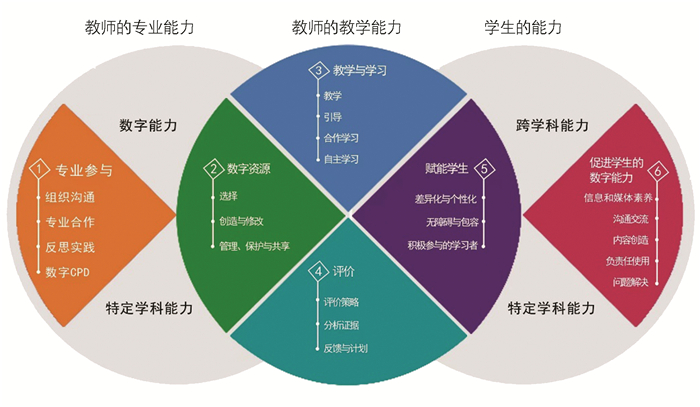-
我们正处在一个日新月异的数字时代,数字技术的发展、当代社会与教育的需求,都与过去大不相同。在技术革命与创新的推动下,数字化转型正在重塑社会、劳动力市场以及未来的工作。不可否认,数字技术与互联网的发展已经促使教育方法发生改变,对即时性教学的需求推动了有别于传统面对面教学法的教学新样态的发展,如翻转课堂、混合式学习、在线学习等。新兴教学方式的出现对教师的专业知识与能力提出了新的要求。
为了更好地提升教师的数字能力,在学校教育中整合数字技术与教育内容,促进学生数字能力的获得,相关研究者、国际组织或国家已先后开发/制定出多种促进教师数字能力发展的框架或标准,如米什拉(Mishra)和科勒(Koehler)基于舒尔曼(Shulman)学科教学知识(PCK)提出的“整合技术的学科教学知识”(TPACK)框架,联合国教科文组织发布的《教师信息和通信技术能力框架》(ICT-CFT),美国国际教育技术协会(ISTE)发布的《ISTE教育者标准》,国际培训、绩效和教学标准委员会(IBSTPI)制定的《IBSTPI教师能力标准》,我国的《中小学教师信息技术应用能力标准(试行)》以及《师范生信息化教学能力标准》等。这些框架或标准通常基于国家法规、教师教育指南、国家课程和国家资格框架研制而成[1],由于国家、组织以及研究者不同,它们可能缺乏对同一结构的共同定义。
2018年,我国教育部印发《教育信息化2.0行动计划》,明确提出要为“信息技术与教育深度融合搭建‘互联网+教育’的大平台,大力提升教师的信息素养”[2],从政策层面明确了数字教育的重要性,并于2019年启动“全国中小学教师信息技术应用能力提升工程2.0”。然而,当前我国教师的信息化教学创新能力仍然不足,教育系统只是借助数字技术来创新课程教学方法或更新教学技术,提升数字能力尚未真正融入教学理念和人才培养目标,难以适应我国教育信息化2.0行动计划要求。
欧盟委员会于2017年发布的《欧盟教师数字能力框架》(European Digital Competence Framework for Educators,简称DigCompEdu) 旨在超越文化与教育背景,构建一个原则上适用于所有教师的数字能力框架,为数字时代的教师专业发展、教师准入以及高质量教师教育绘制了一个共享的标准[3]。该框架在欧盟乃至国际范围内获得广泛赞誉,西班牙和挪威还在其基础上分别发布了本国的教师数字能力框架。
全文HTML
-
关于教师所需能力的讨论,不可避免地会与特定的教育文化、对教育的期望及教师的专业地位联系在一起[4]。教师能力意味着教师在某种情况下表现得专业而恰当,并有效和高效地实现预期[5]。由于数字革命已经改变了人们获取信息、交流和学习的方式,特别是随着数字设备的普及,教师肩负帮助学生获得数字能力的责任,要求教师必须发展个人的数字能力,以适应21世纪的教育需求。基于此,欧盟委员会在《公民数字能力框架》(The Digital Competence Framework for Citizens,简称DigComp)的基础上,设计了特别指向教师这一专业群体的数字能力框架。
出台DigCompEdu旨在为欧洲各级各类教师提供一个通用的参考框架,支持其特定数字教育能力的发展。与其他许多关于教师能力的框架不同,欧盟委员会在DigCompEdu中使用“educator”而非“teacher”来泛指任何参与教学或传播知识的人。它特别面向所有正式和非正式教育环境中的教师,包括从基础教育到高等教育再到职业教育、成人教育和特殊教育以及其他非正式学习环境中的教师(如家庭教育者),涵盖教师职前培训和职后持续的专业发展。
-
鉴于DigCompEdu的服务目标,设计一个适合欧盟所有国家的跨国框架需要了解国际和欧盟层面已经开发的相关数字能力框架、自我评价工具和培训方案,以便发展一个超越文化和教育背景、能与现有政策产生共鸣的共同参考框架。由此,欧盟委员会主要从两个方面开展框架的设计工作:(1)对现有框架、自我评价工具、指导方针、概念模型和用于教师数字能力发展的工具进行深入分析、归纳和总结;(2)与专家和利益相关者进行广泛协商,以细化、修正和验证在前一阶段开发的概念模型。
首先,欧盟委员会围绕50多个相关工具,对其基本结构与成分进行分析,排除不够健全或不够详细,或者在焦点和范围上有很大不同的工具,最后选定其中32个作为起草第一份框架草案的基础。其次,将所选工具中的基本元素映射成能力,并聚集成能力域,同时将由此定义的能力域映射到原始框架,以验证其一致性。再次,将研究结果与专家和利益相关者(如政策制定者、教师、研究者)进行广泛协商,并与之进行面对面或在线研讨,在现有研究基础上初步构建教师数字能力框架。最后,将框架草案与利益相关者进行公开在线磋商,听取公众的反馈与意见,以进一步明确框架的要素与结构,最终形成由六大能力域22项能力指标构成的DigCompEdu。该框架不仅为欧盟数字教育提供了一个科学合理的背景框架,更为教师数字能力模型的开发者,即欧盟各成员国、地方政府、相关国家和地区机构、教育组织以及公共或私人教育培训提供者等,提供了一个共同的参考框架和语言,可助力国家、区域和地方教师的数字能力发展。
一. 研制背景
二. 设计原则
-
DigCompEdu由六大能力域及其下的22项教师所特有的数字能力构成。为了让教师更加明确如何发展自身的数字能力,该框架还提出了教师数字能力等级,并描述了每一能力等级的发展过程,旨在阐释教师数字能力发展的不同阶段或水平,帮助教师了解个人在数字能力发展过程中的优势和劣势,使其能更有针对性地对自我数字能力加以诊断和提升。
-
教师需要具备特定的符合其职业需求的专业数字能力,能充分利用数字技术潜能推进教育创新。为了回应日益增长的数字教育需求,DigCompEdu研制者特别考虑了技术在教育中作为创新推动者的角色,并将教师的数字能力描述为专业能力,以反映数字时代教师的技能需求和变化,有助于数字技术在教育中的整合和创新应用。图 1展示了六大数字能力域及22项能力指标。
① 资料来源:Redecker C.European framework for the digital competence of educators:DigCompEdu.Publications Office of the European Union,2017.
能力域1为“专业参与”(Professional Engagement),包括教师组织沟通、专业合作、反思实践及持续专业发展(Continuous Professional Development,简称CPD)4个方面的能力。该能力域指向更广泛的专业环境,描述教师高效、恰当地应用数字技术以及应用数字技术与同事、学生、家长和其他利益群体进行专业合作与交流的能力。此外,它还强调教师个体和集体反思其教学实践、批判性评价其数字教学策略,并积极推动个人专业发展和组织集体进步的能力。
能力域2为“数字资源”(Digital Resources),侧重于教师数字资源的选择、创造和修改以及管理、保护与共享所需的能力。它包括教师需负责任地使用和管理数字资源,并根据数据保护条例保护数据隐私,如数字考试或学生成绩,同时在修改和发布数字资源时遵守版权法。
能力域3为“教学与学习”(Teaching and Learning),包含教学、引导、合作学习和自主学习4个方面的能力,着眼于教师如何在学习过程中的不同阶段规划、设计和安排数字技术在教学实践中的应用。它侧重于教师应用数字技术的能力,以促进学生合作学习与自主学习,并强调在以学生为中心的学习过程中,教师需要为学生提供有效的指导与支持。
能力域4为“评价”(Assessment),包含评价策略、分析证据以及反馈与计划3个方面的能力,强调教师应用数字技术加强评价的能力。它指向教师运用数字策略评价学生表现和学习需求,并全面分析学生的行为数据,为学生提供有针对性的反馈和建议,同时及时调整教学策略。
能力域5为“赋能学生”(Empowering Learners),包含差异化与个性化、无障碍与包容、积极参与的学习者3个方面的能力,侧重于在以学生为中心的教学和学习策略方面,教师如何充分发挥数字技术潜力的能力。它强调教师应具备使用数字技术促进差异化和个性化学习的能力,创建基于学生能力、兴趣和学习需求的学习活动和体验,满足学生的多样化需求。同时,教师还应鼓励学生积极参与数字活动,确保每一名学生,包括有特殊需要的学生公平地享有使用数字技术的机会。
能力域6为“促进学生的数字能力”(Faci-litating Learners’ Digital Competence),包含信息和媒体素养、沟通交流、内容创造、负责任使用数字技术以及问题解决5个方面的能力,强调教师促进学生数字能力所需的特定教学能力。研制者认为,具有数字能力的教师应该促进学生数字能力的发展,使他们能够安全、负责地管理数字风险和使用数字技术。教师应提高自我的信息和媒体素养,并将数字技术整合于教育活动,使解决数字问题、创造数字内容和应用数字技术进行交流与合作成为可能。
-
为了帮助教师更好地评价与发展自我数字能力,DigCompEdu研制者还提出了教师数字能力等级(具体见表 1)。该套能力等级参照了《欧洲语言共同参考框架》(Common European Framework of Reference for Languages,简称CEFR),将教师的数字能力划分为6个不同等级(A1至C2),每一能力等级逐次递进,以描述教师数字能力的进步程度,并帮助教师明确在当前等级进一步提升数字能力的具体步骤。为了鼓励教师使用DigCompEdu,并将其作为职业发展的工具,研制者还将教师的能力等级与具有激励作用的角色描述相结合,以激励教师进行持续的专业发展,不断提高自我数字能力。受布鲁姆教育目标分类法的启发,DigCompEdu研制者将教师角色划分为A1新手(Newcomer)、A2探索者(Explorer)、B1整合者(Integrator)、B2专家(Expert)、C1领导者(Leader)、C2开拓者(Pioneer)6个等级。
① 资料来源:Redecker C.European framework for the digital competence of educators:DigCompEdu.Publications Office of the European Union,2017.
由表 1可得知,新手(A1)和探索者(A2)的典型能力特征为“意识”与“探索”,指向数字能力处于初级水平的教师,他们能吸收新的数字信息,意识到数字技术在促进教学和专业实践方面的潜力,并在一些领域有意义地使用基本的数字技术。整合者(B1)和专家(B2)的典型能力特征为“整合”与“专长”,指向数字能力处于中级水平的教师,他们能开展并拓展和反思个人数字实践,同时在多元环境下以各种策略整合数字技术与教育。领导者(C1)和开拓者(C2)的典型能力特征为“领导”与“创新”,指向数字能力处于高级水平的教师,他们能与同行分享个人的专业知识,批判现有的实践并尝试开展新的数字实践,如开发新的数字教学方法和评价策略。可见,从A1到C2是能力水平逐渐提升的一个发展过程,遵循从“知道”“领会”到“应用”“分析”,最后到“评价”“创新”这一发展逻辑,其中A2与B1、B2与C1之间存在一个认知上的飞跃。
-
为了更好地帮助教师了解个人目前的数字能力水平、已经取得的成就以及下一步努力的方向,DigCompEdu研制者在能力等级的基础上,结合能力域,进一步阐释了教师数字能力的发展过程,并对每一能力域的发展特征进行了描述(见表 2)。需要注意的是,对教师数字能力的描述并不是为了规范或考查教师,而是鼓励教师进一步发展数字能力,帮助其明确每个能力域的不同发展水平以及进入更高阶段的具体措施,从而一步一步增强教师的信心与能力。
① 资料来源:Redecker C.European framework for the digital competence of educators:DigCompEdu.Publications Office of the European Union,2017.
表 2展示了各个能力域中不同能力等级发展的重点。如能力域2(数字资源)中,要达到整合者(B1)的水平,意味着教师目前的能力发展重点是将数字资源整合到学习环境中,使二者相适应。达到该能力等级的教师下一步将进入专家(B2)等级,需要在B1的基础上策略性地应用互动资源。就此而言,对各能力等级发展重点的描述也与教师的相对优势和角色有关。例如,探索者(A2)可以识别学生在应用数字技术时所遇到的困难;整合者(B1)比较适合寻找新的想法或工具,而专家级别的教师(B2)则可能更擅长决定如何实现这些想法;领导者(C1)和开拓者(C2)将会创新专业实践,充分利用数字技术的创新潜力,培养学生的数字能力。
每一种能力都有特定的发展过程,这取决于所涉及的能力特征以及随着能力等级提高而发展的方式。值得注意的是,所有能力等级都是累积递进的。除了最低级别A1外,每个更高级别的能力都包括所有较低级别的能力。例如,数字能力处于专家(B2)级别的教师具备从A1到B2所有级别的数字能力,但尚缺乏C1和C2的某些能力,如知识、技能或态度。从这个意义上讲,他们需要弥补这些方面的不足以达到更高的能力等级。此外,在不同能力等级的发展过程中,不同能力域可能会出现相同的能力描述关键词。如,在开拓者(C2)阶段,除了能力域2(数字资源)以外,其他5个能力域均出现了“创新”这一关键词;在专家(B2)阶段,能力域2、4、5、6均出现了以“策略性”为关键词的能力描述。
为了更好地理解教师数字能力的发展过程,以下将以能力域3(教学与学习)中的“自主学习”能力为例,详细阐释教师数字能力的发展过程及典型特征。“自主学习”指教师利用数字技术支持学生自主学习的能力,即:使学生能够规划、管理和反思自己的学习,并提供进步证明,分享见解,提出创造性的问题解决方案。为了达到上述目标,教师需进行以下4种类型的活动:(1)利用数字技术(如博客、日记、计划工具)让学生规划自己的学习;(2)利用数字技术(如音频、视频、照片等)让学生收集证据并记录学习进展;(3)利用数字技术(如电子作品集、学生博客)让学生记录和展示个人作品;(4)利用数字技术让学生反思和评价个人学习过程。表 3呈现了“自主学习”能力所涉及的数字能力等级、典型特征及其描述。
① 资料来源:Redecker C.European framework for the digital competence of educators:DigCompEdu.Publications Office of the European Union,2017.
值得关注的是,每个能力等级都对关键词如“很少”“鼓励”“应用”“全面”“批判性反思”“新方法”等进行了强调,以凸显各个能力等级的典型特征,强调与其他能力等级的区别。此外,对能力的描述具体并使用了陈述性语句,以帮助教师明确每个能力等级的标准以及当前自己所处的水平和达到下一目标需要努力的方向。
一. 构建横向数字能力域
二. 设定纵向数字能力等级
三. 阐释能力发展过程和特征
-
DigCompEdu研制者认为,教师的数字能力由知识、技能及态度构成,其中技能维度占主导地位。因此,能力域2至能力域5是DigCompEdu的核心领域,即教师的教学能力。在不考虑不同学科的特殊性与局限性的背景下,它们强调教学与学习过程,共同解释教师的数字教学能力,即教师发展高效、创新的教学与学习策略时所需的特定数字能力。其中,能力域2、能力域3、能力域4分别阐述了如何在规划、实施、评价教学与学习时有效地应用数字技术。能力域5则强调数字技术有助于发展以学生为中心的教学与学习策略,它与能力域2、能力域3、能力域4相互作用,共同构成教师的数字教学能力。而能力域1和能力域6则作为DigCompEdu核心领域的补充,分别从教师的专业能力和学生的能力两个视角进一步阐释如何在更广泛的专业环境下,发展教师特定的数字教学能力,促进学生数字能力的发展。
可见,教师数字能力的发展已超出具体的教学与学习情境,需考虑整体的教育环境。此外,这种对教学能力的关注,使DigCompEdu能够在不断变化的技术环境中适用于所有学科,培养教师特定的学科能力及跨学科能力。它明确描述了如何有效地将数字技术整合到教学中,如何使用数字技术来优化教学策略,有哪些主要目标引导这些策略的实施,以及随着经验和能力的丰富与提升,教师如何应用数字技术促进教育创新。
-
能力是一个复杂抽象的概念,是认知与元认知元素动态混合的结果[6]。数字能力涉及广泛的技能,包括认知和情感技能以及有效利用数字环境的社会学知识。因此,对教师数字能力的认定并不是一个简单或直接达成一致的过程。在这样的条件下,似乎很难衡量教师数字能力水平处于何种水平。
DigCompEdu研制者基于《欧州语言共同参考框架》(CEFR)的层次法设计了教师数字能力等级,并将其与激励作用相结合,从新手(A1)到开拓者(C2)划分了6个连续发展的等级,并概述了各等级的特征。基于此,教师可以很清楚地认识到当前个人数字能力处于何种水平。同时,由于各个能力等级之间存在较大差异,因而也可以让教师集中于某一具体能力的发展,以更快进阶到下一能力等级。此外,6个能力等级还为教师数字能力的发展提供了衡量标准,有助于教师在职业生涯中的成就获得认可。DigCompEdu划分的能力等级与欧盟其他广泛采用的框架(如CEFR)具有很高的一致性,从实践推广的角度来看,DigCompEdu不仅有利于利益相关者的接受和理解,更有利于国家、地区或教师个体间能力等级的比较。需要强调的是,尽管DigCompEdu为教师数字能力提供了共享标准,但其设计目的并不是作为一个规范框架或测评工具,而是期望通过能力等级的划分激励教师持续的专业发展,帮助教师明确在当前阶段进一步提高个人数字能力的具体措施。
-
技术已极大地改变了当下人们的工作方式与生活方式,数字能力被认为是驾驭当代和未来生活的必要条件。随着数字变革的加速,教育也必须进行相应的改革。数字时代的教育转型是整个社会的一项共同任务,这种转变应包括加强国家、地区、学校、教师等利益相关者之间的对话和伙伴关系。面对21世纪高质量教育的需求,数字能力应成为所有教师的核心能力,并嵌入教师专业发展的所有领域,包括职前和职后教师教育。为了实现这一目标,有效的数字能力规划和发展对教师而言至关重要。
DigCompEdu研制者从专业参与、数字资源、教学与学习、评价、赋能学生以及促进学生的数字能力6个方面定位教师数字能力的发展方向,认为它们是建立21世纪高质量教育生态系统的关键要素。在确定关键能力域之后,DigCompEdu研制者在每个能力域下又细分了若干二级能力指标,以指导每个能力域的具体发展。这些能力指标与21世纪社会数字化转型对人才的高质量需求紧密相关。教师不仅要具备数字技能与数字知识,更要具备数字态度与数字自信,这样才能有效和创造性地使用数字技术,助力学生获得数字技能,同时确保所有学生平等地使用数字工具。此外,DigCompEdu在内容设计上还坚持以学生为中心,认为赋能学生、促进学生的数字能力也是21世纪教育转型对教师的要求。在以学生为中心的教育环境中,教师可以灵活满足学生的独特需求,实现差异化与个性化教学,这不仅有助于信息时代学生个性化能力的发展,更有助于教育环境从传统和标准化环境转变为更加灵活的技术强化的数字教育环境。
一. 强调以教学为核心的框架设计
二. 嵌入层次结构的发展框架
三. 面向高质量教育生态系统的能力定位
-
自2017年发布以来,DigCompEdu已被欧盟许多国家或地区翻译成不同的语言,并作为促进本国或地方教师数字能力提升的指导性框架。国家、地区、地方当局、学校领导及其他利益相关者是DigCompEdu的主要实施者与推动者。一些欧盟成员国,如德国的萨尔州已将DigCompEdu纳入教师教育课程,并作为教师数字能力培养的总体要求和行动指南。此外,葡萄牙和克罗地亚也正在考虑将其列入未来教师教育指导方针。西班牙的一些高等教育机构也计划将其作为学术人员持续专业发展的一部分。一些学术组织,如德国成人教育协会对该框架也非常感兴趣,计划将其用于成人教育者数字能力的培养。可见,是否将DigCompEdu整合到国家指导方针和相关课程或活动,很大程度上取决于国家的现实需求、具体情况和政策方向。
然而,在国家或区域层面正式采用和整合DigCompEdu并非框架研制者的主要目标,出台框架旨在促进教育创新与教育变革。许多研究证明,数字教育政策只有在获得教师支持,并最终促进其受益的情况下才会成功[7]。因此,为了让教师熟悉DigCompEdu,并愿意在发展数字教学能力的实践中遵循其主要内容,欧盟委员会还开发了一款简称为“自拍”(Self-reflection on Effective Learning by Fostering the use of Innovative Educational technologies,简称SELFIE)的在线评价工具[8],帮助教师通过创新型教育技术的使用,将数字技术嵌入教学、学习和学生评价。SELFIE是连接DigCompEdu的有效评价工具,教师可以很容易地通过它对个人的数字能力发展进行自我评价。目前,SELFIE已有30多种语言版本,它收集并吸纳了教师、学生和学校领导在学校教育中如何应用数字技术的观点。
SELFIE的开发与实施伴随着利益相关者共同体的建立,参与成员包括由欧洲各地学校、教育部门和研究机构组成的专家团队以及由学校领导、教师和学生组成的实践者团队,他们共同参与了工具的概念设计,并交流在不同环境下使用该工具进行自我评价的经验。SELFIE的开发经历了专家咨询、前测和题项修订的迭代过程[9],主要依据3项基本原则进行:(1)凝练和简化DigCompEdu的主要思想;(2)将DigCompEdu中的能力描述转化为教师可以参与的实践活动;(3)在22项能力指标中,根据教师的个人能力等级,向教师提供有针对性的反馈。
基于这3项基本原则,开发团队确定了22个题项,每个题项对应一项能力,并陈述性地具体描述了每一项能力的核心。此外,考虑到教师数字能力发展的实际,DigCompEdu设定的6个能力等级(A1至C2)被转换为一个5点量表,作为每个题项5个可能的答案:没有使用、基本使用、有意义使用、系统使用、创新使用,教师被要求选出最能反映他们实际的答案。每个答案依次计分0、1、2、3、4,所有题项的总分从0分到88分不等,不同总分分别对应教师数字能力的6个不同等级。有研究者通过对该工具的德语版所收集的一组教师数据进行分析,发现该工具显示出高信度和高效度[8]。目前,许多欧盟教育机构已将SELFIE纳入持续专业发展培训,作为教师个人评价或集体评价的一种有效方式。
-
框架是支持假设、理论和概念体系的实用工具。自2017年发布以来,DigCompEdu已受到欧盟诸多成员国的认可与支持,纷纷以此作为参照设计适合本国的教师数字能力框架或标准。如西班牙的《教师数字能力共同框架》(the Common Framework of Digital Competence for Teachers,INTEF),它以DigCompEdu为基础,定义了教师数字能力的广度和深度,并从信息与信息素养、交流与合作、数字内容创造、安全、问题解决5个维度,对本国教师数字能力发展提出了统一目标和一致要求。
为了进一步检验DigCompEdu的实用性,一项实证研究对包括DigCompEdu在内的目前国际上影响较大的7个教师数字能力框架或ICT能力标准进行了比较分析。该研究采用专家判断法,基于一定标准与专家能力系数筛选专家。该方法与德尔菲法相似,通过专家知识系数与论证系数对7个样本的内容与结构进行赋分。研究结果显示,DigCompEdu得分最高,整体表现最优[10]。这表明,相对于其他6个框架或标准而言,DigCompEdu的结构稳定性、内容实用性与有效性都最高。
一. 评价工具与方法
二. 实施效果
-
当前,网络教育、在线教育、智慧教育等新兴数字化教学形式在我国得到广泛关注与重视,特别是突发公共卫生事件极大地凸显了数字教育的重要性与必要性,从国家到地方先后出台了许多政策文件以保证数字教育的顺利实施。然而,推动数字教育的落实很大程度上依赖于教师的专业数字能力。欧盟面向教师制定的DigCompEdu,对我国教师数字能力的提升具有重要启示。
-
当前,我国教育部已发布了面向中小学教师的信息技术应用能力标准,但其他教育领域,如职业教育、高等教育、特殊教育的教师尚无类似标准。因此,有必要构建一个原则上适用于所有教师的数字能力框架,以共同的语言和逻辑为起点,为教师数字能力发展设定共同标准,确保教师数字能力发展的均衡性。
构建一个适合我国教师数字能力发展的框架,首先,框架内容应与我国当前的教育政策和社会经济发展需求保持一致。其次,利益相关者需要对高质量教师达成共识,明确他们需要具备哪些方面的能力,在对专业学习需求的理解上,要致力于在概念上把数字能力的不同方面塑造成一致、简洁、灵活和直观易懂的模型。这要求利益相关者对数字教育有清晰的认识,以确保所确定的能力适合教师专业工作的各个方面。再次,制定一套嵌入层次的数字能力评价标准,为教师在数字知识、技能和态度等方面的发展提供参照依据,并实现与他国能力标准的互认与转化。最后,框架应具备普遍性、稳定性、灵活性,适用于不同的教育环境,并能够随着技术的进步而适时调整,同时为教师的创新发展留出空间,这也是前瞻性教育环境的核心要求。
一个结构良好的教师数字能力框架能够协调不同利益者的诉求,并作为21世纪教育教学创新的助推器。在微观层面,它可以支持教师的数字实践以及持续的专业发展。在中观层面,它可以加强地方教育治理,将学校能力建设与教师和学生的数字能力发展联系起来,支持个人和机构层面的有效专业发展。在质量保证的宏观层面,它可以为职前教师教育、职后教师持续专业发展及有效教师教育提供参考标准。
-
DigCompEdu研制者认为,一个结构良好的框架不仅有助于为教师数字能力发展设定官方目标或标准,还有助于教师在理解自身能力水平和专业发展目标的反思过程中发挥作用。然而,要成为变革的催化剂,框架还必须吸引来自基层的一线教师。只有当大多数教师认为框架是一个有用的指导方针,利于他们的专业发展,他们才会愿意将它作用于其能力发展上。
教学是一个从自我评价到改进发展的循环过程,一个有效的自我评价工具对教师教学能力的发展具有重要意义。从内部来讲,通过自我评价工具,教师可以很容易地对自我数字能力发展进行评价,并将结果转化为教师可以关联的专业活动,从而进一步提升自我专业能力。从外部来看,自我评价工具有助于教师数字能力框架的稳定实施,使框架运用不再被认为是一个自上而下的外部强加的结果。自我评价工具对促进教师和学生在教育和跨教育环境中的学习伙伴关系具有变革性力量。一方面,它可以促进教师不断提升其专业能力,这也是教师作为适应性专业人员的基本特征,他们应在知识、技能、态度等方面持续更新与发展以赋能学生;另一方面,它可以激发教师的积极性和能动性,促进教师有效利用数字技术的潜能,培养学生成为21世纪有韧性、有责任意识和反思批判精神的人才。
-
尽管数字革命给我们的工作与生活带来了前所未有的机会与活力,但数字技术依然未能与教育系统、学校教学和个人学习有效融合。当前,我国对于教师数字能力的研究主要集中在理论层面,相关实践层面的检验还较少,为了应对21世纪高质量教育的挑战和需求,必须不断深化关于教师数字能力的理论与实践研究,为教师的数字能力发展提供有力的学术支撑。
一是厘清“数字能力”的相关概念。有效使用技术的能力被认为是一项关键能力,尽管它非常重要,但许多不同的术语都被用来描述这些技能和能力,如“ICT技能”“数字技能” “数字素养”“媒体素养”“数据素养”等,导致与技术相关的能力在定义和概念上呈现出复杂格局。目前所使用的术语可能反映了过去几十年技术的快速发展,但随着技术的不断更新,具体的“技能”似乎已经被“素养”和“能力”所取代,这在一定程度上反映了人们对能力的新需求,即不仅要具备“数字技能”,还需具备相关的数字知识与态度。
二是明晰“数字能力”的内涵。如前所述,受技术发展的影响,不断变化的术语引发了人们对新能力的思考。随着数字技术与传统媒体的不断融合以及社交媒体对传统媒体的颠覆性影响,数字能力从技术起源到涵盖更为广泛的维度,包含了更广泛、更复杂的知识、技能和态度。态度在这方面尤为重要,人们需要以一种特定的心态来适应新的数字需求[11]。由于增加了这些新的需求,对“数字能力”的定义也需要有更广泛的讨论。
三是理解教师数字能力的维度。目前关于教师数字能力的研究已有不少,一些作者试图通过回顾教师数字能力的文献来分解教师数字能力的维度,发现大多构成教师数字能力的模型都包括两大维度:技术能力和教学能力[1]。除了这两个关键维度,态度或与技术相关的更广泛的社会层面的问题,如网络道德也常被涵盖在模型中。事实上,不同的模型旨在从不同的角度及广度与深度捕捉教师的数字能力。一些模型由该领域的研究人员提出,一些则来自国家认证要求和标准,还有一些是借鉴他国的数字能力框架。因此,我们需要辩证地看待现有关于教师数字能力维度的研究,立足本土教育实践,设计适合本国教师数字能力发展的维度,并构建相应理论模型,以此在理论探索与实践检验上共同推动教师数字能力的高质量发展。




 下载:
下载: